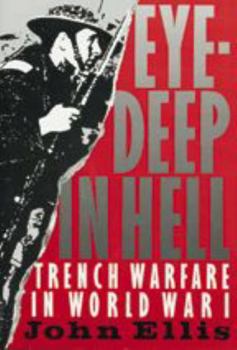Eye-Deep in Hell: Trench Warfare in World War I
Select Format
Select Condition 
Book Overview
Millions of men lived in the trenches during World War I. More than six million died there. In Eye-Deep in Hell , the author explores this unique and terrifying world--the rituals of battle, the... This description may be from another edition of this product.
Format:Paperback
Language:English
ISBN:0801839475
ISBN13:9780801839474
Release Date:September 1989
Publisher:Johns Hopkins University Press
Length:224 Pages
Weight:1.07 lbs.
Dimensions:0.9" x 6.9" x 10.0"
Age Range:18 years and up
Grade Range:Postsecondary and higher
Customer Reviews
6 ratings
Lest We Forget
Published by Jacket.books , 3 years ago
A gripping overview of what it was like to live and die in the trenches of the Western Front. It doesn't pull any punches with its literary and visual depictions of the brutality of the conflict but I think that is the point.
The Trench War Reviled
Published by Thriftbooks.com User , 20 years ago
A well written book, easy to grasp and very informative. The horrors of the trench war are well described. One of the best books on the subject!
Non 'Dulce' Non 'et Decor'
Published by Thriftbooks.com User , 21 years ago
John Ellis, a military historian, wrote "Eye Deep in Hell" to explain the daily routines of the fighting men of World War I. The title of the book comes from the poet Ezra Pound, who wrote an epitaph for the soldiers who survived and died on the mud caked battlefields. Pound's poem adequately reflects the true nature of trench warfare during this meat grinder of a war. WWI was not a glorious call to arms or a romantic charge on a horse between dashing young men; it was attrition warfare on a massive scale, killing millions with little movement on both sides. Unfortunately, WWI is largely forgotten today because most of the veterans are gone and the bigger death tolls of WWII overshadowed the millions killed during 1914-1918.You will not find much here about the causes of WWI or detailed explanations about the movements of troops during battle. Ellis concerns himself with how the men survived on a day-to-day basis, in those times between the grinding offensives. What quickly emerges in Ellis's book is a vivid picture of the utter despair of life in the trenches, lives mired in rampant disease, hunger, violent death, misery, and inclement weather. How anyone survived this war with their sanity intact is a mystery for the ages.Ellis covers every conceivable aspect of daily routine and life in the trenches by dividing his book into four sections. The first part of the book describes the type of trenches built along the front. The first trench line was where the soldiers charged the enemy when an offensive took place. Connected to this trench by shorter trenches were reserve lines where soldiers could retreat if necessary, and where supplies of ammunition, food, mail, and clothing where moved to the front. Attached to the front line trenches were saps, little trenches running out into no man's land where observers attempted to keep an eye on the enemy lines. Also built into the trenches were dugouts, or deep bunkers where the officers lived. The men slept either against the trench wall or in little dugouts along the trench lines. Of course, sleep was a luxury few could afford. When the men were not watching the enemy lines, they were putting up barbed wire in no man's land, helping to reinforce or dig trenches, or moving supplies. All of these activities often took place in deep mud, standing water, and piles of poorly buried corpses. As if dealing with these conditions were not bad enough, there was the constant threat of violent death. Men died when shot by snipers, from shell fragments and stray bullets, from grenades tossed in the trenches, from chlorine and mustard gas shells (a horrible, lingering death), and trench cave-ins. There were a thousand ways to die in the trenches, and precious few ways to live.Ellis's second section deals with combat conditions. Offensives were never non-stop operations, but usually had a lengthy buildup. Soldiers knew they were in trouble when the shelling started in earnest. The constant shelling was an attempt to
The Great War
Published by Thriftbooks.com User , 21 years ago
Short and to the point. After reading this book you will understand why of all the wars in the past 200 years WW1 is called the "Great War".
Excellent book on trench warfare & culture
Published by Thriftbooks.com User , 25 years ago
This is one of the finest books in my WW1 library. Next to the books by Lyn McDonald. I have recommended this book to those who are just beginning their studies on the war. Ellis has done a fine job--very concise, very human and extremely well written. I highly recommend it.
A searing glimpse at the individuals caught in mass warfare
Published by Thriftbooks.com User , 26 years ago
As a young girl, I was transfixed by the emotional battleground depicted in Vera Brittain's TESTAMENT OF YOUTH. This experience soon filled my bookshelves with World War I literature. EYE DEEP IN HELL is filled with the just the sort of human detail that connects the reader with the participants in the Great War. Everything is there-from battles to satirical songs to the chief survivors of horrific battles: the lice! We suffer with trench foot and hope for a "blighty"--the wound that will send us home. We are supplied with endless quantities of plum and apple jam, yet long for drinkable water. We long for home--yet find that the trench line is a psychological barrier that separates a soldier forever from the non-soldier. I would heartily recommend this book to any reader who wishes to read social history at its most riveting.





